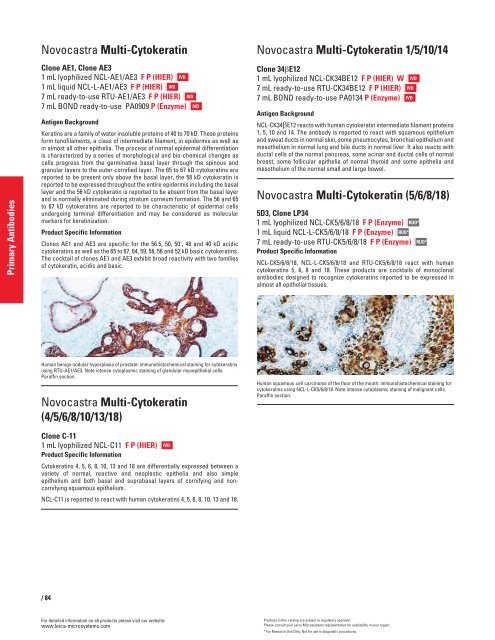QF0159 Marketing Release Record
QF0159 Marketing Release Record
QF0159 Marketing Release Record
You also want an ePaper? Increase the reach of your titles
YUMPU automatically turns print PDFs into web optimized ePapers that Google loves.
Primary Antibodies<br />
Novocastra Multi-Cytokeratin<br />
Clone AE1, Clone AE3<br />
1 mL lyophilized NCL-AE1/AE3 F P (HIER)<br />
1 mL liquid NCL-L-AE1/AE3 F P (HIER)<br />
7 mL ready-to-use RTU-AE1/AE3 F P (HIER)<br />
7 mL BOND ready-to-use PA0909 P (Enzyme)<br />
Antigen Background<br />
Keratins are a family of water insoluble proteins of 40 to 70 kD. These proteins<br />
form tonofilaments, a class of intermediate filament, in epidermis as well as<br />
in almost all other epithelia. The process of normal epidermal differentiation<br />
is characterized by a series of morphological and bio-chemical changes as<br />
cells progress from the germinative basal layer through the spinous and<br />
granular layers to the outer cornified layer. The 65 to 67 kD cytokeratins are<br />
reported to be present only above the basal layer, the 58 kD cytokeratin is<br />
reported to be expressed throughout the entire epidermis including the basal<br />
layer and the 56 kD cytokeratin is reported to be absent from the basal layer<br />
and is normally eliminated during stratum corneum formation. The 56 and 65<br />
to 67 kD cytokeratins are reported to be characteristic of epidermal cells<br />
undergoing terminal differentiation and may be considered as molecular<br />
markers for keratinization.<br />
Product Specific Information<br />
Clones AE1 and AE3 are specific for the 56.5, 50, 50', 48 and 40 kD acidic<br />
cytokeratins as well as the 65 to 67, 64, 59, 58, 56 and 52 kD basic cytokeratins.<br />
The cocktail of clones AE1 and AE3 exhibit broad reactivity with two families<br />
of cytokeratin, acidic and basic.<br />
Human benign nodular hyperplasia of prostate: immunohistochemical staining for cytokeratins<br />
using RTU-AE1/AE3. Note intense cytoplasmic staining of glandular myoepithelial cells.<br />
Paraffin section.<br />
Novocastra Multi-Cytokeratin<br />
(4/5/6/8/10/13/18)<br />
Clone C-11<br />
1 mL lyophilized NCL-C11 F P (HIER)<br />
Product Specific Information<br />
Cytokeratins 4, 5, 6, 8, 10, 13 and 18 are differentially expressed between a<br />
variety of normal, reactive and neoplastic epithelia and also simple<br />
epithelium and both basal and suprabasal layers of cornifying and noncornifying<br />
squamous epithelium.<br />
NCL-C11 is reported to react with human cytokeratins 4, 5, 6, 8, 10, 13 and 18.<br />
/84<br />
For detailed information on all products please visit our website:<br />
www.leica-microsystems.com<br />
IVD<br />
IVD<br />
IVD<br />
IVD<br />
IVD<br />
Novocastra Multi-Cytokeratin 1/5/10/14<br />
Clone 34�E12<br />
1 mL lyophilized NCL-CK34BE12 F P (HIER) W<br />
7 mL ready-to-use RTU-CK34BE12 F P (HIER)<br />
7 mL BOND ready-to-use PA0134 P (Enzyme)<br />
Antigen Background<br />
NCL-CK34�E12 reacts with human cytokeratin intermediate filament proteins<br />
1, 5, 10 and 14. The antibody is reported to react with squamous epithelium<br />
and sweat ducts in normal skin, some pneumocytes, bronchial epithelium and<br />
mesothelium in normal lung and bile ducts in normal liver. It also reacts with<br />
ductal cells of the normal pancreas, some acinar and ductal cells of normal<br />
breast, some follicular epithelia of normal thyroid and some epithelia and<br />
mesothelium of the normal small and large bowel.<br />
Novocastra Multi-Cytokeratin (5/6/8/18)<br />
5D3, Clone LP34<br />
1 mL lyophilized NCL-CK5/6/8/18 F P (Enzyme)<br />
1 mL liquid NCL-L-CK5/6/8/18 F P (Enzyme)<br />
7 mL ready-to-use RTU-CK5/6/8/18 F P (Enzyme)<br />
Product Specific Information<br />
NCL-CK5/6/8/18, NCL-L-CK5/6/8/18 and RTU-CK5/6/8/18 react with human<br />
cytokeratins 5, 6, 8 and 18. These products are cocktails of monoclonal<br />
antibodies designed to recognize cytokeratins reported to be expressed in<br />
almost all epithelial tissues.<br />
Human squamous cell carcinoma of the floor of the mouth: immunohistochemical staining for<br />
cytokeratins using NCL-L-CK5/6/8/18. Note intense cytoplasmic staining of malignant cells.<br />
Paraffin section.<br />
Products in this catalog are subject to regulatory approval.<br />
Please consult your Leica Microsystems representative for availability in your region.<br />
* For Research Use Only. Not for use in diagnostic procedures.<br />
RUO*<br />
IVD<br />
IVD<br />
IVD<br />
RUO*<br />
RUO*
















